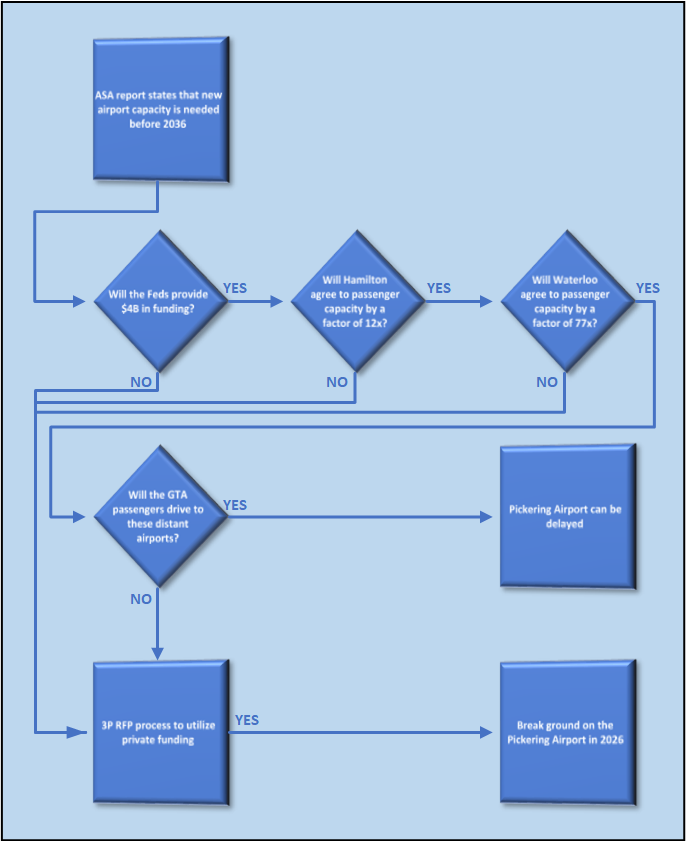
Written by Mark Brooks
The hubris of a new E-petition authorized by Member of Parliament Jennifer O’Connell is raising eyebrows on both sides of the Canadian House of Commons. The reason? It appears to twists the findings of a government report and use misdirection in the wording of the petition. The petition asks the government to transfer a billion-dollar public land reserve from one department to another and in so doing grant extended land leases to an anointed few. It attempts to subvert the decision by the Minister of Transport to preserve these lands for a potential future airport.
The land in question is in Pickering, perfectly placed to support the greater Toronto areas booming growth. It was assembled and preserved at great expense for economic development, a future airport, and greenspace for the good of all Canadians. The shamelessness of the petition reveals an astounding sense of entitlement that a select few corporations and individuals now leasing the land appear to have for a public asset.
Even more astonishing, the “facts” stated in the MP authorized E-petition appear to warp reality. The study mentioned shows both a viable business case for private investment and suggests that it is prudent to break–ground on a new airport in 2026. (Part four of the report, “Revenue Generation and Economic Impact Report”). An earlier 2010 needs assessment study by Transport Canada also showed a need for a new airport in the future.
So, what is really going on here?
The MP (Member of Parliament for Pickering-Uxbridge, Jennifer O’Connell), is no stranger to misinterpreting stated facts. The KPMG study referred to in the E-Petition is the Pickering Lands Aviation Sector Analysis (ASA). The report was prepared for Transport Canada by KPMG LLP Canada with support from WSP Global Inc. In the Executive Summary and elsewhere, the ASA makes it clear that additional passenger airport capacity is need in the greater Toronto area before 2036 and that a new passenger airport in Pickering will eventually be needed (page 18). It states that the opening of a new passenger airport can be delayed beyond 2036 only by undertaking billions of dollars of development to maximize passenger capacity at other locations in the Southern Ontario airport system. This would displace existing non-passenger traffic that in many cases is already constrained.
It’s important to point out that the ASA report focused mostly on passenger capacity and ignored Utility Aviation. Today, even in a pandemic, Utility Aviation is booming in the Toronto area airports that are setup and priced to handle this type of traffic. As of September 2020, nearby Oshawa Airport is now above pre-pandemic traffic levels according to the airports manager Steven Wilcox during a September 29th virtual workshop. The airport is in the process of removing a flight school, Canadian Flight Academy, to reduce congestion and associated aircraft noise. Unlike Pickering airport, which will be buffered by greenspace and industry, Oshawa airport has 14,000 homes within a 2 km radius. The Academy has launched a lawsuit to fight to maintain access to the airport and continue to provide educational services to hundreds of students.
The ASA report shows that Pickering Airport has a known, viable business case that can provide much needed capacity by utilize private funding. Building capacity elsewhere would require extensive government funding and ongoing tax payer support. These actions have not been reflected in regional development plans, do not have local support, would displace lower value traffic, and are not expected to be undertaken.
The MP famously released a statement on March 5th, the day the KPMG ASA report was made public, that appeared to misinterpret the results of the study. To be fair, the report’s findings are broken into four sections that appear to provide conflicting conclusions and are using outdated data. One example of this is the passenger capacity forecast in Part One of the report that relies on the least restrictive metric – runway capacity. Later parts of the report then expand on this data point by adding conditions to the final overall conclusions on page 334. Over all the report is poorly written from a layman’s point of view, but the most salient points are crystal clear. The misinterpretation by the MP, including past misstating of dates, is now becoming something of a legend. She has done this so often that it is Trump-like and makes for easy fodder for fact-checkers to list.
One section of the ASA report does say a new passenger airport is not needed before 2036 if a number of other conditions are met. Those conditions would require billions of dollars in capital investments at Waterloo and Hamilton airports before 2036. Another section of the KPMG ASA report then openly states (on page 223) that those expansions would be expensive and are not justifies based on forecast passenger demand at these locations! The idea that billion-dollar government funded developments at other airports is needed has been completely ignored by the MP. It is possible that the MP reads the poorly-worded phrase “modest improvements” used in reference to this and missed the idea that a massive buildout of terminal space and gates would be needed.

While some of the MP’s initial misstatements may be forgiven as a moment of wishful thinking in the support of a cause, that was over six months ago. One would hope that if an MP references a report that someone on her staff would have found the time to read at least part of the 492–page consultant’s report or discussed its findings with Transport Canada officials in order to correct her misunderstandings. Again, to be clear, the report states that Pickering Airport passenger capacity is not immediately needed, but the airport itself is financially viable (+8% IRR, page 395) and suggests opening a new industrial utility airport before existing maximum passenger capacity is reached. (see page 334 of the ASA report).
Is this simply a case of not understanding the report’s findings? Is it playing politics with donors and supporters, or something worse? The MP has yet to issue a retraction of the misleading March 5th statement and has refused to meet with pro-airport supporters for years.
Today, the majority of the airport lands are “temporarily” being leased to a number of commercial farms nicknamed the ‘Big Five’. The petition envisions turning over management of the Pickering Airport land–leases from Transport Canada to Parks Canada and extending these leases. This would shift the focus from economic development for the benefit of all to agricultural development for the benefit of the Big Five. A nifty trick for those lucky enough to have a land–lease, but certainly not in the interests of the tax–payer that currently owns the billion–dollar public land reserve.

A recent Freedom of Information request on who is leasing the airport lands also shows that the majority of the rest of the land is leased by a handful of unknown individuals and entities who have had their names redacted. This lack of transparency raises the opportunity for corruption and insider influencing.
This lack of transparency combined with the display of hubris and entitlement shows an opportunity for a government dustup similar to the infamous WE scandal.
Is a government MP attempting to use tax–payer resources to reward supporters? Favouring a few that have benefited from the use of the lands for decades rather than seeking the greatest benefit for the Region, the Province, and Canada? The E-Petitions tactic, if successful, could give control of a billion-dollar asset to an anointed few people/business in perpetuity.
What is the relationship between the MP and these anointed few? The tax payer and voters demand transparency here.
If successful, the petition would also turn Parks Canada from a protector of the land into the role of a commercial agricultural landholder. This is an untenable situation that appears to conflict with Parks Canadas mandate which is:
On behalf of the people of Canada, we protect and present nationally significant examples of Canada’s natural and cultural heritage, and foster public understanding, appreciation and enjoyment in ways that ensure the ecological and commemorative integrity of these places for present and future generations.
The idea of warping or modifying this mandate to enable commercial farm corporations to lease large sections of parkland is a horrible precedent that could undermine the whole parks system. Turning a billion-dollar government owned urban land reserve into a “Park”, just so it can then be leased out for pennies on the dollar of its commercial value to businesses is deeply disturbing. To do so in the middle of a pandemic, with many of the identities of the benefactors’ unknown raises the specter of corruption and insider profiteering. To do so by mis–stating the findings of a million-dollar government report is downright Orwellian.
The question now is, “How many Canadians will be misled into signing this Machiavellian abomination of a Petition?”
Will the MP withdraw her authorization of the petition or standup in the House of Commons and proudly present it from the government benches?
What does the Minister of Transportation, the Honorable Marc Garneau, say?
If the Minister of Transportation wants to head–off this brewing scandal, he can. It is within his power to terminated any and all the Pickering Airport land–leases today. That would end the hubris and sense of entitlement by the anointed few. Removing some of the leaseholders would also enable an efficient cleanup, environmental assessment, and remediation of the land before breaking ground on a new airport in 2026.
By value, one third of all global trade (goods and services) moves by air. It is time to kickstart our pandemic–ravaged economy by inviting investors to build a new industrial airport in Pickering.
References:
Study finds that a new Airport in Pickering is needed
The Parks Canada mandate and charter ( Parks Canada Agency )
Revenue Generation and Economic Impact Report – Pickering Lands Aviation Sector Analysis
Pickering Uxbridge riding – Jennifer O’Connell MP
A Review by the author of the contents of the KPMG ASA study
Government of Canada– Previous needs assessment also showed a need for Pickering Airport
The build Pickering Airport Last strategy
False, repetitive and strident…